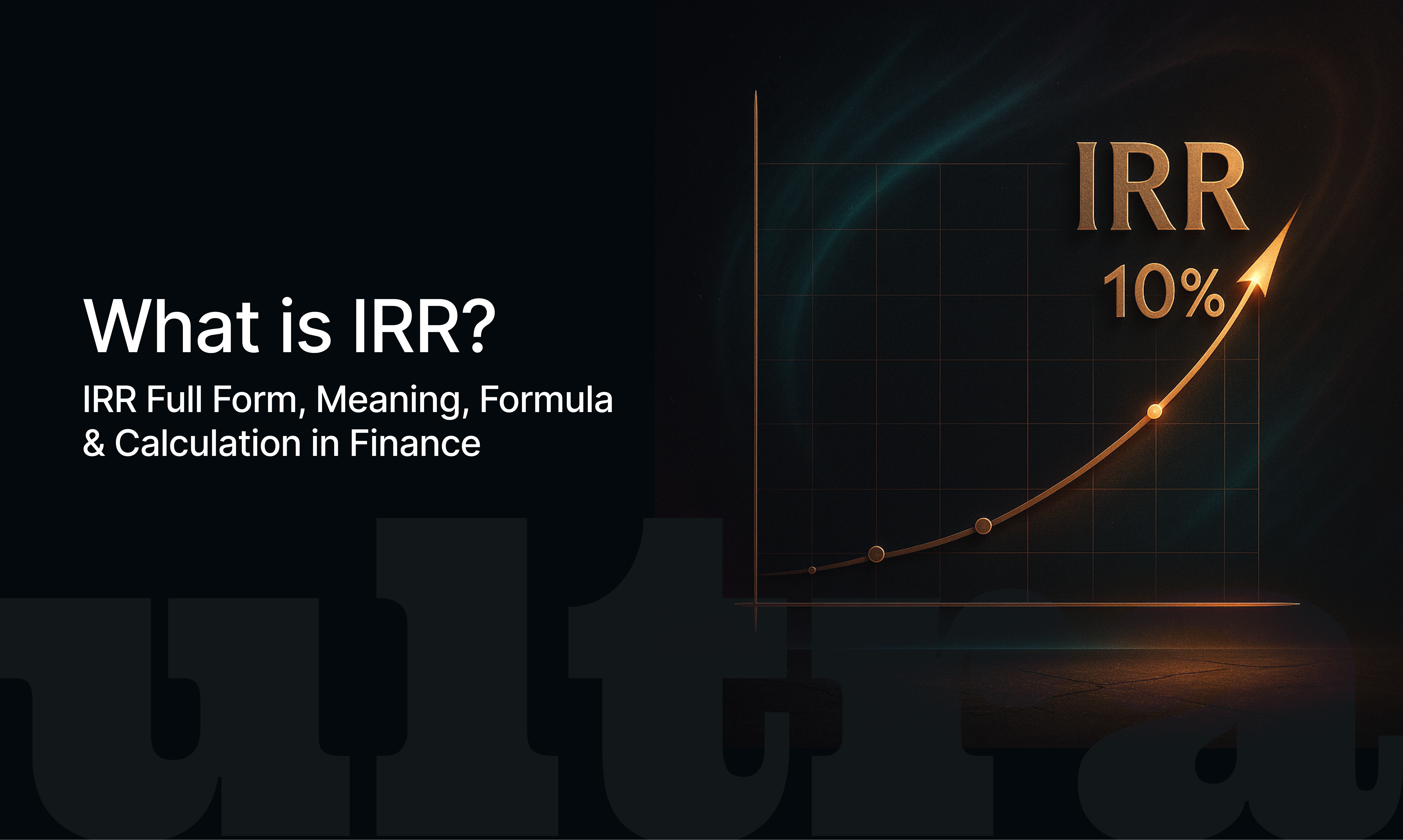IRR Full Form, Meaning, Formula & Calculation in Finance
29 July 2025 · Sachin Gadekar
A complete guide to understanding Internal Rate of Return (IRR), its formula, importance, and application in financial analysis.

Introduction
In the world of investment and finance, evaluating the profitability of a project or investment is crucial. One of the most widely used metrics for this purpose is IRR, which stands for Internal Rate of Return. Whether you're a financial analyst, investor, or entrepreneur, understanding what IRR means and how it is calculated can significantly improve your decision-making.
What is IRR (Internal Rate of Return)?
IRR, or Internal Rate of Return, is the interest rate at which the net present value (NPV) of all cash flows (both inflow and outflow) from a project or investment becomes zero. It’s a tool used to estimate the profitability of potential investments.
In simpler terms, IRR is the rate at which your investment breaks even, considering the time value of money. A higher IRR indicates a more profitable investment.
IRR Full Form in Finance
IRR Full Form: Internal Rate of Return
Used In: Financial modeling, investment planning, business feasibility studies, private equity, and corporate finance.
Why is IRR Important?
IRR helps businesses and investors:
Compare the profitability of multiple projects.
Decide whether to accept or reject a project.
Measure expected growth rate of an investment over time.
How to Calculate IRR
IRR Formula
While calculating IRR manually can be complex due to its iterative nature, the mathematical formula used for NPV (which is set to zero) is:
NPV = ∑ [Ct / (1 + r)^t] - C0 = 0
Where:
Ct = Cash flow at time t
C0 = Initial investment
r = IRR (rate to be calculated)
t = Time period
Solving this equation requires trial and error or financial calculators/software like Excel.
Calculate IRR:
1. Using Excel or Google Sheets
Use the built-in formula:
sql
CopyEdit
=IRR(values)
Where "values" is the series of cash flows (including the initial investment as a negative number).
Example:
If your investment has the following cash flows:
Year 0: -₹1,00,000 (initial investment)
Year 1: ₹30,000
Year 2: ₹40,000
Year 3: ₹50,000
Then use:
CopyEdit
=IRR({-100000, 30000, 40000, 50000})
The result will be your IRR.
IRR vs NPV vs ROI
| Metric | Description | Key Focus |
|---|---|---|
| IRR | Interest rate at which NPV = 0 | Rate of return |
| NPV | Total value today of future cash flows | Value generation |
| ROI | Gain from investment as a percentage | Overall return |
Applications & Limitations
Applications of IRR in Finance
Capital Budgeting: Helps in choosing among mutually exclusive projects.
Private Equity & VC: Used to estimate return expectations.
Personal Finance: Evaluate real estate or business investments.
Loan Analysis: Understand interest vs return trade-offs.
Limitations of IRR
Multiple IRRs: When cash flows fluctuate between positive and negative, more than one IRR can exist.
Reinvestment Assumption: IRR assumes that intermediate cash flows are reinvested at the same rate, which may not always be realistic.
Misleading for Mutually Exclusive Projects: Projects with higher IRRs may not always have the best NPV or absolute returns.
Modified IRR (MIRR)
To overcome the reinvestment rate assumption, MIRR (Modified Internal Rate of Return) is used. It provides a more accurate picture by assuming reinvestment at the cost of capital or some other realistic rate.
IRR Meaning in Real-World Scenarios
Real Estate Investment:
Helps determine if a property will yield better returns than fixed deposits or mutual funds.
Startup Investment:
VCs use IRR to compare startup opportunities and exit strategies.
Corporate Projects:
Companies use IRR to evaluate machinery purchases, expansion plans, or new product launches.
Final Thoughts
The Internal Rate of Return (IRR) is a powerful financial metric that helps evaluate the potential profitability of an investment or project. While it's not without limitations, IRR remains one of the most important decision-making tools in finance.
Whether you're a beginner trying to understand what is IRR, or a professional comparing IRR formulas, this metric is essential for strategic investment planning.
For access to multiple investment opportunities with optimized returns, check out Ultra – your trusted partner in building long-term financial growth.
FAQs on IRR (Internal Rate of Return)
1. What is IRR in simple words?
IRR is the rate at which the present value of future cash flows from an investment equals the initial cost, making the net present value zero.
2. How is IRR different from ROI?
ROI gives a percentage return without considering the time value of money, while IRR incorporates the timing of cash flows.
3. Can IRR be negative?
Yes, IRR can be negative if the investment never recovers its initial cost or results in a net loss.
4. Is a higher IRR always better?
Generally, yes, but context matters. A project with a higher IRR but lower NPV may not be better than one with slightly lower IRR and higher absolute returns.
5. What is the ideal IRR?
It depends on your cost of capital or benchmark return. Ideally, IRR should be higher than the required rate of return or inflation.